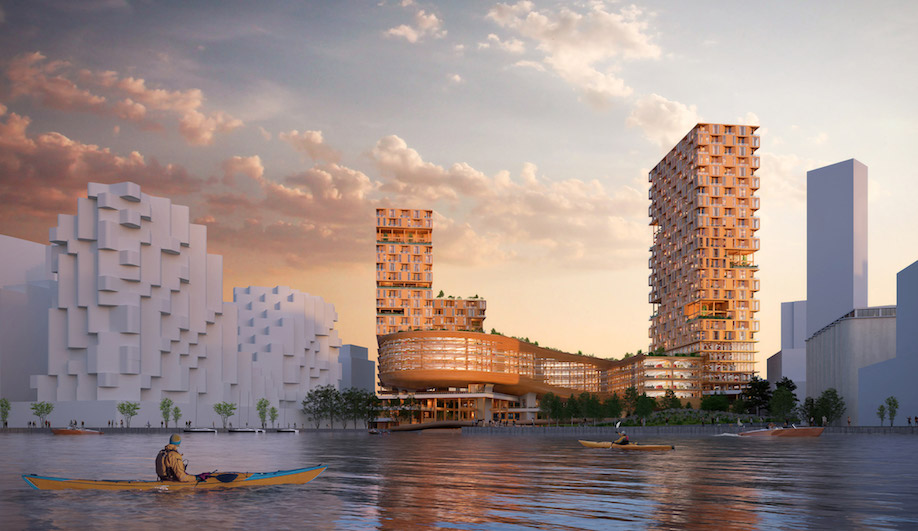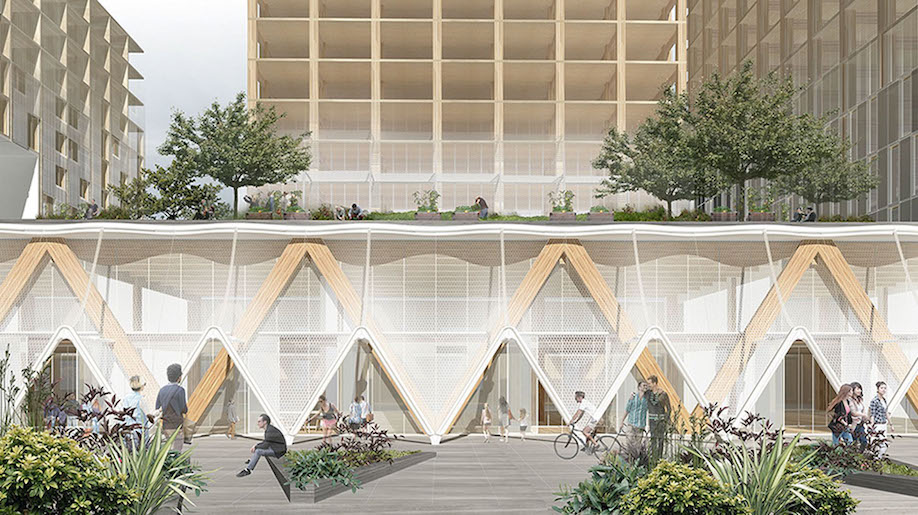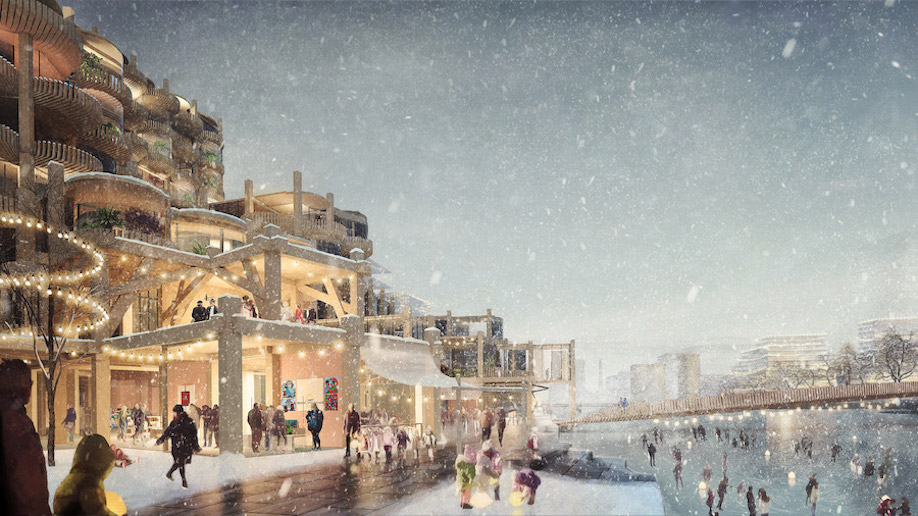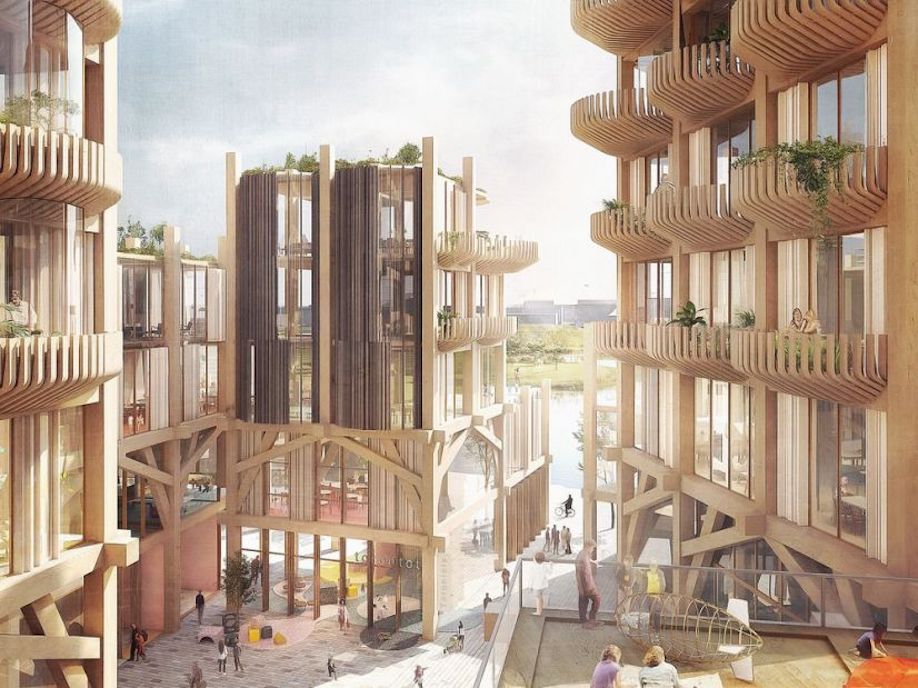
Amid the myriad vacant lots and construction cranes of Toronto’s eastern downtown waterfront, the nondescript building at 307 Lakeshore Boulevard is previewing elements of its city of the future. Here, at the central office and “experimental workplace” of Google affiliate Sidewalk Labs, a sort of futuristic tent hangs from a building now fronted by a series of heated and LED-infused concrete pavers.

Building on Sidewalk’s initial aspirations to create new paradigms for street-level urbanism, the first prototypes of a heated hexagonal sidewalk, and a notional “building raincoat” awning system, are on display to the public at 307 Lakeshore.

Immediately drawing the eye, the raincoat is a flexible tensile awning designed by Partisans in collaboration with local climate engineering firm RWDI. Made from a thin but highly durable ETFE membrane, the structure is pitched against the building, creating a protected pedestrian space below. In a city as cold as Toronto, the hope is to create more comfortable year-round conditions, and a livelier public realm. At street level, the liminal space is meant as an intermediary between the built environment and the outdoors. If the raincoat system can help bring people outside, Quayside could become a hub of year-round activity.

Partisans has created an engagingly kinetic design for the raincoat, guided by RWDI’s analysis of wind-flow mitigation to devise a comfortable pedestrian environment. RWDI’s data suggests that the raincoat could effectively double the amount of time people could comfortably spend outdoors. Would it work? There’s reason for optimism. Part of the raincoat’s ingenuity is in its ability to serve dual purposes, with a public art projection already displayed to enticing effect on the prototype. Even in the dead of winter, it sparks curiosity. It’s an intriguing and worthwhile concept, though it might risk imposing a sense of street-level homogeneity if applied on a larger scale.

Then there’s the hexagonal concrete pavers. Heated and lit, the pavers promise an antidote to Toronto’s notoriously icy sidewalks. For people with mobility issues, the promise is nothing short of liberating. The LED lighting system allows for flexibility of uses, with the colours denoting whether space belongs to pedestrians, cyclists, or vehicles, at any given time. This allows for a mix of uses throughout the day, and for pedestrian space to be maximized during low-traffic periods. The hexagonal mosaic conjured by the pavers is also touted as a place-making gesture, one that offers a distinctive design in knitting together a cohesive urban identity.

These prototypes are the latest in a series of technological innovations proposed as part of an increasingly controversial development that promises to be North America’s largest smart neighbourhood. In 2017, Sidewalk Labs was awarded a contract to develop the 12-acre Quayside site as a community built “from the internet up” in partnership with public agency Waterfront Toronto.
As the controversies ramped up, so did the architectural ambitions. In 2018, Sidewalk revealed plans to use mass timber as Quayside’s primary high-rise building material, with Katerra and Michael Green Architects (MGA) tapped to develop a flexible new building system for the 12-acre site, which would include a mix of market-rate and subsidized housing, and a combination of rental and condominium tenancy.

This year, Sidewalk has gradually rolled out details of its evolving plans, each step dogged by growing concerns about data privacy, lack of public input, an opaque RFP process and, just last month, the revelation of Sidewalk’s hopes to gain a portion of public tax revenue in exchange for building transit and infrastructure.

This ambition to collect public tax revenue has been cited as a fundamental encroachment of corporate influence in public interests by those who have been calling for the project’s wholesale cancellation. Writing in the Toronto Star, data governance advocate Bianca Wylie argues, “Sidewalk Labs isn’t just relying on utopian architectural renderings of new construction to entice us: they are selling us fear. Fear that our government will fail us yet again. Fear that if this company doesn’t do it, nobody will.” It’s a sobering thought, and one that’s difficult to reconcile with the proposal’s laudable aspects.

The project’s design strengths and public-policy weaknesses are at such odds that they make any attempt at holistic evaluation difficult. How do we judge a heated sidewalk against concerns about data privacy? What’s the value of an artful awning system compared to the threat of private encroachment on public goods? To be sure, the new prototypes have merit, but they’re hard to weigh amidst these larger concerns.
